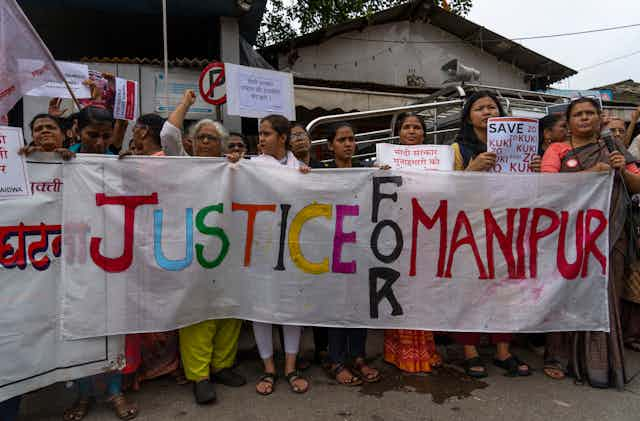A mass burial for 35 people from the Kuki tribe killed in ethnic violence in India’s Manipur state was recently put on hold after opposition from the state’s Meitei community.
The dispute over the burial site is the latest episode in an ethnic conflict that has rocked Manipur. For months, Manipur in northeastern India has seen ethno-religious violence between the majority Hindu Meitei community and the Kuki and Naga tribal communities who are predominately Christian.
Since May, the stream of violence has claimed the lives of over 180 people and has displaced thousands. Despite the violence, the central government only responded with statements after images of a shocking attack on two women were shared online.
In late July, a harrowing video emerged of two Kuki women being paraded naked through the streets of a small Manipur village by a group of men. One of the women was then allegedly gang-raped. News reports stated the men were allegedly from the Meitei community.
Government inaction
Opposition Members of Parliament have brought a no-confidence motion against Prime Minister Narendra Modi, citing his government’s failure to respond to the violence.
After the video was widely shared online, and more than two months after the violence first broke out, Modi finally made a statement. He called it a “shameful incident,” and said state governments should strengthen their legal systems to protect India’s “mothers and sisters.”
However, his statement also included examples of violence in states run by the opposition, and did not condemn the violence more broadly. The parliament has been in session since July 20, but the prime minister has yet to make an appearance to discuss the situation in Manipur.
Many of India’s political elite have remained deafeningly silent or have engaged in whataboutism. When the Minister of Women and Child Development, Smriti Irani, was questioned in parliament about the violence against women in Manipur, she evaded responsibility and pointed to violence in opposition ruled states.
This most recent incident is yet another indication of India’s indifference towards violence against women. The current administration has also been clear and consistent in its apathy towards marginalized and minority communities.

The women in the video have since filed a petition with the Supreme Court of India. Lawyers representing them have alleged that police collaborated with the perpetrators. In a statement, the Indian Supreme Court said violence against women in Manipur has reached an “unprecedented magnitude.”
What’s behind the violence
Manipur is a small state of around three million people in the northeast of India bordering Myanmar. Manipur’s proximity to international borders with Myanmar has made it prone to insurgency and conflict. Instances of ethnic violence are often attributed to decades of unresolved strife between various tribal and non-tribal groups.
This ongoing violence was triggered by the Manipur High Court’s decision in April 2023 to include the state’s majority Meitei community in the list of Scheduled Tribes. Categorizing a group as a Scheduled Tribe provides members of the group with special constitutional safeguards — at least on paper.
The Meitei community performs better than other ethnic groups in Manipur on many social indicators, such as access to employment and educational opportunities.
Kuki and Naga tribal communities fear that if the Meitei are categorized as Scheduled Tribes, that would strengthen their already greater political influence in the state. The tribal communities also fear it would allow Meiteis to buy land and settle in Kuki areas.
This strife has led to churches being burned, sexual violence, killings and other atrocities.
In response to the outbreak of violence in May, the Manipur state government shut down internet services. The order issued by the government read that “anti-social elements” were using social media to incite the “passions of the public” and it was a necessary measure to stop the spread of disinformation.
Arbitrary internet shutdowns for a wide variety of reasons have become all too common, despite a 2020 Supreme Court of India ruling that declared suspending the internet a “drastic measure” that state governments must employ only if “necessary and unavoidable.”

Why has Manipur been ignored?
The states of northeastern India have long been seen as developmentally and geographically peripheral by the central government. States like Manipur have been subjected to “neocolonial governance” and have not benefited from social, political or economic development because they are often viewed as “amorphous shadowlands” within India.
People in the region have often been neglected and positioned as outsiders by the rest of India. Successive central governments have often viewed those in the northeast as objects to be militarized, policed and disciplined. Manipur has also been subjected to abusive laws such as the Armed Forces Special Powers Act, which grants the Indian Armed Forces special powers to maintain order in “disturbed areas.” This militarization has contributed to perpetual violence in the region.
India’s democratic veneer has helped it evade international scrutiny for the ongoing ethnic violence in Manipur. International outrage at what has happened in Manipur has been minimal.
Read more: India is using the G20 summit to further its settler-colonial ambitions in Kashmir
In fact, Modi received a red carpet welcome in the so-called bastions of democracy, namely the United States in late June and France in mid-July.
In response to a question from a reporter about declining respect for human rights and democracy, Modi responded that democracy is in India’s DNA and has been delivered for all regardless of caste, creed, religion and gender.
Modi’s visit to France in July to pen new defence deals coincided with European Parliament’s adoption of a resolution urging Indian authorities to take action to stop the violence in Manipur. However, there was no push back from the French president.
If states like the U.S. and France truly believe in human rights, they must take a much stronger stance on India’s draconian shift towards authoritarianism and illiberalism.


